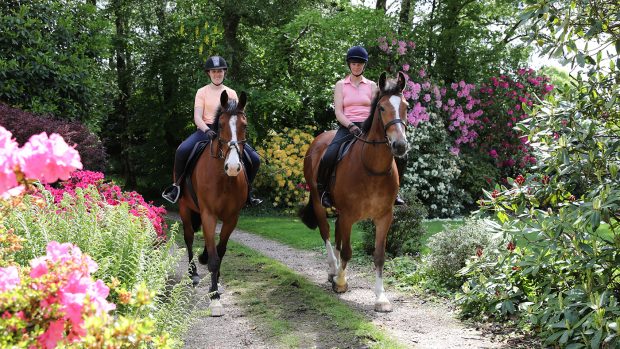Whether it’s due to bad habits, over enthusiasm or tension, being left dangling with one foot in the stirrup as your horse walks off can be a recipe for disaster. Lottie Buttler asked Jason Webb of Your Horsemanship how to train a horse to stand quietly beside the mounting block and to stay still throughout the mounting process
How to teach a horse to stand still for mounting
Teaching your horse to stand still while mounting is 90% groundwork. You need to be able to move your horse forwards, backwards and sideways. You should also be able to move away from him while he stands still for a minimum of 30 seconds — I call this parking. This work sounds easy, but it takes some practice.
What’s the best approach?
Before you attempt to position your horse near a proper mounting block, you need to de-sensitise him to the action of getting on and off the mounting block. Your horse should be comfortable with you jumping up and down alongside him at the very least. Then, to get him used to a mounting block, if you have a light weight one, pick it up, throw it in front of you and then follow, leading your horse.
When the horse is comfortable with that, start throwing it back past the side of him and following it. If you have a fixed or heavy block, use something else to simulate it, like a plastic water bucket. When the horse is fully de-sensitised to the block, he should be comfortable with you pushing it all around him, and even under him.
What’s the next step?
Once your horse is confident with the first two exercises, practice positioning your horse one step at a time beside an imaginary mounting block.
Try to do this while staying in front of them. I use a whip as an extension of my arm to gently encourage them to move forwards, backwards and sideways as required. Once in position, leave him “parked” until he relaxes, then give him a rub to reward him. Repeat until he is doing it easily and without question, before moving onto a real mounting block.
When you have your horse standing by the mounting block, expand on the rubbing by doing it all the way down each side, including from the mounting block. If the horse moves away, go back to the front and move him back into position by asking him to move the opposite way to how he stepped out of position. For example, if he steps forward, get him to step back. If he stepped back, bring him forward.
Once your horse can stand while you give him a rub all over from the mounting block, get down, lead him away and repeat. It’s the repetitions of this that make horses good to mount. Being able to do this three or four times in a row would be a good session.
What if my horse swings his quarters away?
Practice getting a turn on the forehand from the ground. Being able to do this is great for correcting horses that shuffle their hind end away when you’re about to get on.
Start by teaching your horse to do a static flexion. Static flexions are like carrot stretches, but you train them to do it as a response to the bit. Apply a gentle pressure on the bit and release when they stop moving and offer a bend. Eventually your horse will bend without moving.
Next, check your horse can move their hind end over from a simple gesture or cue. He should already be responsive to this from your previous work moving them forwards, backwards and sideways.
Once your horse is comfortable with static flexions and moving the hind end over, it’s time to put the two together. Stand to the left of your horse with the reins over their neck. Put your hands into a riding position from the ground then bend him to the right, rewarding him whenever he offers to bend. Your left hand on the left rein acts as a break if he moves forward. You can adjust your hands up and down the reins as you see fit.
To initiate the turn on the forehand, bend your horse to the right and follow their head round. As you do, you will get to a point that you can see the right side of your horse. From here cue your horse to move their hind end towards you. When he does move, watch his feet — the back legs should pivot around the right foreleg (turn on the forehand). Your horse is unlikely to do this straight away, so you may need to stop with the left rein and start again, or persevere until you see the correct step. Release and reward whenever you see a correct step. As your horse starts to realise what you are asking, he will respond to a light pressure on the right rein. Timing is key!
Then, if he tries to swing his quarters as you mount, you can pick up your right rein and he will step his hind end back towards the block.
Other useful tips to teach a horse to stand still for mounting
When you’re getting on, prepare your reins so you are able to shorten your left rein. This allows you to bring your horse around you should he move off as you’re getting on.
It is important that you and your horse are not in a hurry to move off. A good way to help with this is, after getting on and before you do anything else, work on your static flexions from the saddle. The horse might move off through habit, but work on the flexions until the horse can bend to the left and then to the right without moving.
After a week or two of being consistent with this, mounting issues should be a thing of the past. If you are still having issues while trying to teach a horse to stand still for mounting, this may be because the horse is physically uncomfortable, which could be a saddle-fit problem or a physical issue. In this situation I would organise visits from a professional saddle fitter, equine physio and vet. Remember, a horse in pain is impossible to train.
You might also be interested in:

11 reasons why the fit of your saddle should be checked now
Sue Carson, founder and managing director of Sue Carson Saddles explains why autumn is an important time to check the

Study finds dental discomfort can be identified in a horse’s face using the horse grimace scale

The Ridden Horse Pain Ethogram: how the phrase ‘that’s the way the horse has always gone’ is being challenged
For years it’s been thought that horses who swish their tail, put their ears back and open their mouth when

Subscribe to Horse & Hound magazine today – and enjoy unlimited website access all year round
Horse & Hound magazine, out every Thursday, is packed with all the latest news and reports, as well as interviews, specials, nostalgia, vet and training advice. Find how you can enjoy the magazine delivered to your door every week, plus options to upgrade your subscription to access our online service that brings you breaking news and reports as well as other benefits.



